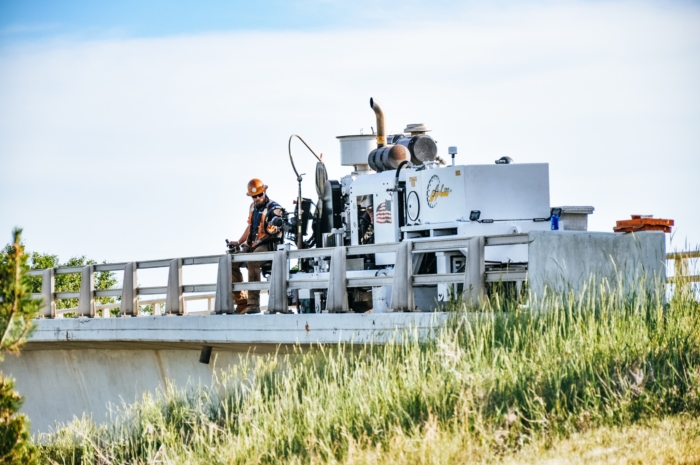What is Concrete Grinding?

Aug/04/21
CONCRETE AND CONCRETE GRINDING
Modern concrete is made up of differing proportions of cement, dry sand, dry stone, and water. Each recipe creates a different form of concrete. Each has differing degrees of strength and durability. Depending on the project and its properties, different mixtures of concrete are selected.
WHAT IS CONCRETE GRINDING?
Concrete grinding is the process of smoothing rough concrete surfaces. During the concrete grinding process, an abrasive tool with diamond attachment smooths the rough surface. All coatings, stains, and surface cracks are removed along with the top layer of concrete during the first step in the process.
Deeper cracks must be evaluated. If they can be patched, this is the time to do so. Professionals use a pressure washer to blast dirt, rocks, and concrete chunks out of the crack. This creates a clean pocket for the application of an epoxy patch.
Concrete can be ground either wet or dry. Many businesses prefer wet applications to prevent concrete dust from getting everywhere. This is both for cleanliness and safety. Rough concrete dust can find its way into workers’ lungs.
Rough grinding begins with a coarse metal bond tool, usually around 40-grit. After the surface is ground, finer grinding can begin. Generally, this is with 80-grit and finished with 120-grit tools. Each step requires at least 2 passes over the entire area to ensure the proper smoothness.
To harden the concrete after grinding, professionals will apply a liquid chemical. Using a broom, the entire surface is saturated with the chemical. At least 30 minutes is needed to let the chemical steep in. But, most workers wait an entire day before undertaking the final polish. If you’re looking for a high gloss finish, 3000-grit does the job.
WHAT KIND OF EQUIPMENT IS USED IN CONCRETE GRINDING?
Concrete grinding requires high-powered concrete grinders. High-powered concrete grinders are circular devices equipped with heavy-duty, diamond-clad rotating polishers. Industrial-strength washers and vacuum cleaners are also used during various steps in the process.
Parts of the process do require more specialized tools. Angle grinders, straight-wheel grinders, and vertical grinders are also used during certain steps. For clean cuts, cut-off tools are useful to make even cuts where needed.
BENEFITS OF CONCRETE GRINDING
- Saves Time & Money. Concrete grinding saves time and money over other floor refurbishment processes. Not only does this make a home project less time-consuming, but saves your wallet some heat as well.
- Increases Safety. Concrete grinding can turn a rough, damaged surface into a smooth, hard surface. This makes it safe for homeowners and visitors to walk on without risk of injury. On driveways, concrete grinding can make for a quieter, and more skid-resistant surface for cars.
- Preps For Projects. Old concrete can become uneven over the years. If a contractor is installing wood or tile floors over a concrete floor, it helps for it to be smooth. Also, the new flooring won’t need constant repairs as gapping occurs.
- Epoxy Floor Finish. Concrete grinding is an excellent way to prepare a floor for an epoxy floor finish. These floors are bright, durable, and easy to clean. They resist water and oil stains, making them last longer than traditional flooring.
- It’s Customizable. Grinding will remove old oil stains easily by skimming off the top layer of concrete. Grinding can be customized to leave a specific amount of texture. Different epoxies need different textures to hold and set.
- Better for the Environment. Concrete grinding produces less pollution and waste than alternate flooring options. It uses fewer raw materials and no harmful chemicals. Due to its longevity, it is a more sustainable option.
CONCRETE GRINDING FOR FLOORING
Homeowners can enjoy beautiful floors with deep concrete grinding. When looking into flooring options, professional grinders will expose the stones in the mix. This reveals the potential look to the homeowner. They’ll do this several times to give the homeowner options. From here, you can decide which flooring type to choose.
The homeowner can opt for certain exposure levels. The concrete grinder will remove the top level of the old concrete to the desired level. Partial exposure can give the floor an attractive salt and pepper look. With other flooring, this would be far more expensive.
A deep, full-stone exposure concrete grinding process can be more expensive. It involves removing up to 6 millimeters of concrete. As compared to other grinding options, the final product reveals more of the stones. Polished deep grinding can make the concrete look like a riverbed.
FOR BEST RESULTS, CONSULT YOUR CONCRETE GRINDING PROFESSIONAL
Homeowners can rent concrete grinders and do the work themselves. But for best results, we recommend you select a reputable concrete grinding firm in your area. Check out local concrete businesses for quotes on your next project.
If you have any questions or concerns about your garage floor, pool deck, patio, basement floor, or sidewalk, give us a call.